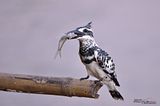So I was talking about the origin of the name Whimbrel in the last post, this post I'll be talking about another even more interesting wader, the Terek Sandpiper (Xenus cinereus). Along with the few Whimbrels that I found at Shouninga-hama beach on September 23, a single Terek Sandpiper was also found feeding in the same area as well. It seemed to be going through a moult from juvenile to non-breeding plumage. The black lines on its scapulars were still visible, but its bill base was already bright yellowish. Last year I've got one bird staying at the river mouth near my place for several days in May. Photos of the last year's individual can be seen here and here. That one was an adult almost in its full breeding plumage with very broad black lines on its scapulars and almost completely dark bill. I'm always happy to get photos of the same species in different plumage.



I've always thought that the name Terek Sandpiper is really something interesting. It reminds me of the name T.rex or Tyrannosaurus rex, one of the most iconic creatures of all time. However, it turns out that the word Terek in the name of the sandpiper originates from the name of a river in Russia. Too bad it doesn't have anything to do with dinosaurs, another disappointment for me. As described by our friend Wikipedia, the Terek River is a major river that flows through Georgia and Russia to the Caspian Sea, the largest enclosed body of water on Earth. This reminds me of another decent East Asian bird, the Amur Falcon (Falco amurensis), which was named after, yes you guessed, the Amur River in Russia (again).



Terek Sandpiper (Xenus cinereus)
The bird that I found at Shouninga-hama beach was surprisingly obliging. My impression on Terek Sandpipers has always been that they are very shy and unapproachable. I can still remember how difficult it was when I tried to photograph the one that I found last year. Surprisingly, the one you see here was nothing more difficult than the abundant and tame Grey-tailed Tattler. However, it was not too easy either as the bird was extremely energetic. It never stopped walking for even a second, well I might exaggerate a little bit here. By the way, it was quite difficult for me to get the right focus as the bird constantly walked further and in a very speedy fashion. Luckily the lighting was unbelievably good and I could shoot at 1/1000 even with ISO 200!






















2 comments:
Why didn't it run/fly away like all the Tereks I see?
Waders have long gone from up here..........
Really beautiful photographs. It's magical you can get so close. Love the colours and the light in the eye.
Post a Comment